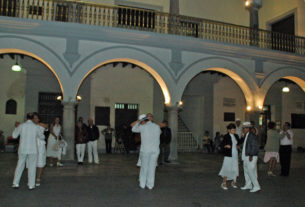Arts of Mexico
This past February I had the pleasure of attending the first concert of the 2005 season given by the Xalapa Symphony Orchestra. It was the first time I had heard the orchestra, and I was impressed by the caliber of its musicians and the breadth of its repertoire. It seemed remarkable that this relatively small city could attract such well-trained musicians who could deliver such a superb performance.
I decided to interview two of its seasoned members, Dawn Droescher and Keith Eitzen. Ms. Droescher and Mr. Eitzen, both French horn players from the United States, have chosen to make Xalapa their permanent home in order to play with the symphony orchestra. I wanted to know more about them and how they had come to make that decision.
Eitzen started by telling me that after graduating from the University of Northern Colorado, he went to Seattle to study under the well-known horn player, Christopher Leuba. Shortly after, a former student of Leuba’s called about an opening with the Xalapa orchestra, and Leuba recommended him. That was twenty years ago.
“Why did you stay so long?” I asked.
“I’ve always wanted to play the French horn,” he answered. “All I can remember ever wanting to do was to play good music. Up north, it’s almost impossible. There just isn’t the money. In Xalapa, the orchestra is subsidized by the university and doesn’t depend on ticket sales to keep going. We can play the big pieces that need lots of musicians, pieces rarely heard. In fact, this year we’ll be playing both Mahler’s and Bruchner’s 7th symphonies. They require full size orchestras – something there’s rarely money for in the United States except for the few really big orchestras. We get a chance to play a large variety of pieces, even modern works like Edgar Valcarcel’s “Concierto indio, para violonchelo y orchesta”, which you heard last night.”
“How did you like playing that piece?” I asked.
“Not much,” he replied. “But we’re committed to introducing the public to modern composers who rarely get a chance to be heard.”
Ms. Droescher, Eitzen’s soon-to-be wife, has been living in Mexico for the past fifteen years. She had recently graduated from the University of Southern California and was continuing her studies under Vincent De Rosa when an opening came up in the Mexico City Philharmonic. She said she had always been performance oriented, and when this opportunity came her way, she was advised to go and check it out.
“If you have a job take it.” she was told. “You can always go back to school.”
“I wasn’t happy with the situation in Mexico City and was ready to return for my Masters,” she continued, “when I heard about the opening at the Xalapa Symphony Orchestra. At first, I went to pay off student loans but soon realized it was a good place to be.”
“What makes it good?” I asked.
“Well, for one thing, job security. Except for the top five orchestras in the United States, there are no benefits and no job security. Also, because of the lack of funding, musicians have had to take salary cuts there. One in three-hundred musicians find work up north, and then they have to pay for their plane tickets just to audition.”
“But why here instead of Mexico City?” I asked.
“As good as the Mexico City Philharmonic is, I prefer Xalapa,” she continued. “The lifestyle is relaxed, more comfortable. You don’t have to hustle. We have job security, medical coverage, Christmas bonuses, and paid vacations. We even get full pay at retirement.”
“And sabbaticals with full salary,” interjected Eitzen.
It seems the good life in Xalapa attracts musicians from all over the world. Among the 100 regulars are musicians from Poland, the Ukraine, Georgia, Bulgaria, Peru, El Salvador, as well as the United States. Americans make up about one-quarter of the orchestra. About one-third of the orchestra is from elsewhere. Little by little, there are good Mexican musicians filling the ranks. Many have studied abroad in one of the more prestigious schools and are returning to their country where the perks are good and the lifestyle, less stressed.
It’s interesting to note that the Xalapa Symphony Orchestra is the oldest continuous orchestra in Mexico. It was founded by a cello playing governor in 1927 and managed to survive on a small government grant until 1975 when it was incorporated into the University of Veracruz. From that point on, the members of the orchestra got paid well year round and received benefits still unheard of for many musicians in North America.
In that same year, Luis Herrera de la Fuente took over the orchestra. With his arrival, the golden age of the Xalapa Symphony began. Not only was he a world class conductor, but he had an energy that made things happen. He raised salaries, booked tours, and brought in internationally known conductors and soloists – all of which helped raise the splendor of the orchestra.
With its growing reputation, musicians started to come from all over the world: Argentina, Belgium, Chile, Korea, El Salvador, the United States, Guatemala, Israel, Peru, Poland, Romania, and what was once the U.S.S.R. Many stayed to take Mexican citizenship and settle in the Xalapa area.
During the reign of Herrera de la Fuenta the orchestra made a lot of recordings and won a number of awards. By the time he left in 1984, the Xalapa Symphony Orchestra was one of the best of its kind.
In 1993, the orchestra was invited to represent Mexico in the International Europelia Festival in Europe. It was acclaimed by the European community. According to the words of the musical director of the Europelia Foundation, “The Xalapa Symphony Orchestra was the best ambassador possible for the music in Mexico.”
In 1996, under the direction of Francisco Savin, the orchestra organized the Primer Festival Junio Musical in Xalapa. This festival brings together artists and national and international organizations with the sole purpose of performing the best in music in all its forms. It was an instant success and the Festival has continued all these years without interruption.
In 2002, Carlos Miguel Prieto became director of the orchestra. It was the same year he received the prize for conductor of the year by the Mexican Union of Music and Theater Critics. This youngest and most versatile of conductors has performed all over the world and in 1998, he received the Mozart Medal for musical merit.
Hard work and dedication has gained Prieto an international reputation, and this reputation has helped him to bring in good conductors and soloists to Xalapa. In the past few years, among the guest conductors he has brought in are Fritz Reiner, Edoardo Mata, and Yoshi Takeda. Among the soloists – Mitslaw Rostropovitch, Claudio Arrau, Henry Syering, and Norman Krieger. For those with an interest in voice – Placido Domingo, Andrea Bocelli, and Luciano Pavarotti.
The night I was there the mix of audience was impressive. The young came in droves in their jeans and Nikes. Many of the kids were still in their teens grabbing up seats for friends. A good number of them were from the university music school – all of whom can go for free. Others, I suspect, are the result of the city’s emphasis on introducing the children to music while still in primary school.
I have never seen a more attentive or involved audience. Every seat was taken. I imagine this is another perk for the musicians lucky enough or talented enough to have acquired a position in the orchestra.
It is clear that music in Mexico is not just for the privileged. The price of tickets is kept deliberately low, and from looking at a cross section of the audience, it’s obvious that everybody goes.
The seventy-five year old orchestra has played in almost every big city and village in Mexico – always with the same high standards. Their repertoire runs the gamut from a tonal modern to standard classical pieces. According to Keith Eitzen, it was seven years before he remembers a work being repeated.
As an aside, I asked both him and Dawn Droescher what their preferences were. For Eitzen it was Brahms and Strauss. “Both,” he said, “have written good French horn pieces.” For Doescher it was Beethoven. “His works are so intelligent even though there aren’t that many parts for the French horn.” They both enjoy the challenge of playing such an extensive repertoire. That also seems to suit the Jarochos of Xalapa, who show their support in their enthusiasm and high turn out at the concert hall.
Arts of Mexico


